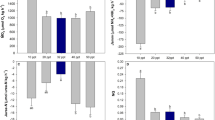Abstract
The rotifer Brachionus plicatilis is euryhaline (growing between 2 and 97 ppt) and has previously been considered an osmoconformer. We suggest that B. plicatilis is an osmoregulator, exhibiting a pattern of Na+/K+ ATPase activity in response to salinity consistent with that of other osmoregulating euryhaline invertebrates. To examine salinity tolerance, growth rates between 5 and 60 ppt were determined. The activity of Na+/K+ ATPase was examined, over the same range of salinities, by measuring ATPase activity in rotifer homogenates in the presence and absence of a Na+/K+ ATPase inhibitor. Maximum specific growth rate (0.95 day−1) occurred at 16 ppt, highest mean amictic eggs per female (1.41) occurred at 20 ppt, and both parameters decreased rapidly as salinity increased. Egg development time was constant with salinity at 0.92 days. The activity of Na+/K+ ATPase per milligram protein increased from 3.9 µmol h−1 at 5 ppt to 6.8 µmol h−1 at 50 ppt and accounted for 15 and 30% of total ATPase activity, respectively. We suggest that these observations are consistent with increasing stress at high salinities and the occurrence of a hypo-osmoregulatory response. Given the high ATP consumption of Na+/K+ ATPase at high salinities, it is possible that a proportion of the corresponding decreases in growth rate and egg production are a direct cost of regulation.




Similar content being viewed by others
References
Axelsen KB, Palmgren MG (1998) Evolution of substrate specificities in the P-type ATPase superfamily. J Mol Evol 46:84–101
Bradford MM (1976) A rapid and sensitive method for the quantitation of microgram quantities of protein utilizing the principle of protein-dye binding. Anal Biochem 151:369–374
Ciros-Pérez J, Carmona MJ, Serra M (2001) Resource competition between sympatric sibling rotifer species. Limnol Oceanogr 46:1511–1523
DeMeester L, Gomez A, Okamura B, Schwenk K (2002) The monopolization hypothesis and the dispersal–gene flow paradox in aquatic organisms. Acta Oecol 23:121–135
Derry AM, Hebert PDN, Prepas EE (2003) Evolution of rotifers in saline and subsaline lakes: a molecular phylogenetic approach. Limnol Oceanogr 48:675–685
Epp RW, Winston PW (1977) Osmotic regulation in the brackish-water rotifer Brachionus plicatilis. J Exp Biol 68:151–156
Epp RW, Winston PW (1978) The effects of salinity and pH on the activity and oxygen consumption of Brachionus plicatilis (Rotatoria). Comp Biochem Physiol A Physiol 59:9–12
Frolov AV, Pankov SL, Geradze KN, Pankov SA (1991) Influence of salinity on the biochemical composition of the rotifer Brachionus plicatilis (Muller). Aspects of adaptation. Comp Biochem Physiol A Physiol 99:541–550
Gomez A, Carmona MJ, Serra M (1997) Ecological factors affecting gene flow in the Brachionus plicatilis complex (Rotifera). Oecologia 111:350–356
Gomez A, Carvalho GR (2002) Sex, parthenogenesis and genetic structure of rotifers: microsatellite analysis of contemporary and resting egg bank populations. Mol Ecol 9:203–214
Gomez A, Serra M, Carvalho GR, Lunt DH (2002) Speciation in ancient cryptic species complexes: evidence from the molecular phylogeny of Brachionus plicatilis (Rotifera). Evolution 56:1431–1444
Guillard RRL (1975) Culture of phytoplankton for feeding marine invertebrates. In: Smith WL, Chanley MH (eds) Culture of marine invertebrate animals. Plenum Press, New York, pp 29–60
Holliday CW (1985) Salinity-induced changes in gill Na, K-ATPase activity in the mud fiddler crab, Uca pugnax. J Exp Zool 233:199–208
Holliday CW (1990) Salinity-induced changes in branchial Na+/K+ ATPase activity and transepithelial potential difference in the brine shrimp Artemia salina. J Exp Biol 151:279–296
Lima AG, McNamara JC, Terra WR (1997) Regulation of haemolymph osmolytes and gill Na+/K+-ATPase activities during acclimation to saline media in the fresh water shrimp Macrobrachium olfersii (Wiegmann, 1836) (Decapoda, Palaemonidae). J Exp Mar Biol Ecol 215:81–91
Lingrel JB, Kuntzweiler T (1994) Na+, K+-ATPase. J Biol Chem 269:19659–19662
Lubzens E, Rankevich D, Kolodny G, Gibson O, Cohen A, Khayat M (1995) Physiological adaptations in the survival of rotifers (Brachionus plicatilis, O.F. Muller) at low temperatures. Hydrobiologia 313/314:175–183
Lubzens E, Zmora O, Barr Y (2001) Biotechnology and aquaculture of rotifers. Hydrobiologia 446/447:337–353
Lucu C, Devescovi M (1999) Osmoregulation and branchial Na+, K+-ATPase in the lobster Hommerus gammarus acclimated to dilute seawater. J Exp Mar Biol Ecol 234:291–304
Lucu C, Flik G (1999) Na+-K+-ATPase and Na+/Ca2+ exchange activities in gills of hyperregulating Carcinus maenas. Am J Regul Integr Comp Physiol 276:R490–R499
Lucu C, Devescovi M, Skaramuca B, Kozul V (2000) Gill Na+, K+-ATPase in the spiny lobster Palinurus elephas and other marine osmoconformers: adaptiveness of enzymes from osmoconformity to hyperregulation. J Exp Mar Biol Ecol 246:163–178
Oren A (1999) Bioenergetic aspects of halophilism. Microbiol Mol Biol Rev 63:334–348
Ortells R, Gomez A, Serra M (2003) Coexistence of cryptic rotifer species: ecological and genetic characterisation of Brachionus plicatilis. Freshw Biol 48:2194–2202
Palmgren MG, Axelsen KB (1998) Evolution of P-type ATPases. Biochim Biophys Acta 1365:37–45
Sambrook J, Russell DW (2001) Molecular cloning: a laboratory manual. Cold Spring Harbor Laboratory Press, New York
Skaer HB (1974) The water balance of a serpulid Polychaete, Mercierella enigmatica (Fauvel) 1. Osmotic concentration and volume regulation. J Exp Biol 60:321–330
Sokal RR, Rohlf FJ (1995) Biometry, 3rd edn. Freeman, New York
Stryer L (1995) Biochemistry. Freeman, New York
Walker KF (1981) A synopsis of ecological information on the saline lake rotifer Brachionus plicatilis Muller 1786. Hydrobiologia 81:159–167
Acknowledgements
This study forms part of a PhD thesis by C.D. Lowe at the University of Liverpool, funded by the Natural Environment Research Council (grant no. NER/S/A/2001/0630). Thanks are offered to Dr. D. Parry who provided advice, equipment, and reagents for enzyme assays. Pierre Ferrer, Stephanie Swift, and Jamie Watson provided valuable assistance with laboratory work. Drs. H. Noyes, I. Saccheri, and P. Watts provided valuable discussion. We also thank two anonymous reviewers for constructive comments.
Author information
Authors and Affiliations
Corresponding author
Additional information
Communicated by J.P. Thorpe, Port Erin
Rights and permissions
About this article
Cite this article
Lowe, C.D., Kemp, S.J., Bates, A.D. et al. Evidence that the rotifer Brachionus plicatilis is not an osmoconformer. Marine Biology 146, 923–929 (2005). https://doi.org/10.1007/s00227-004-1501-9
Received:
Accepted:
Published:
Issue Date:
DOI: https://doi.org/10.1007/s00227-004-1501-9




